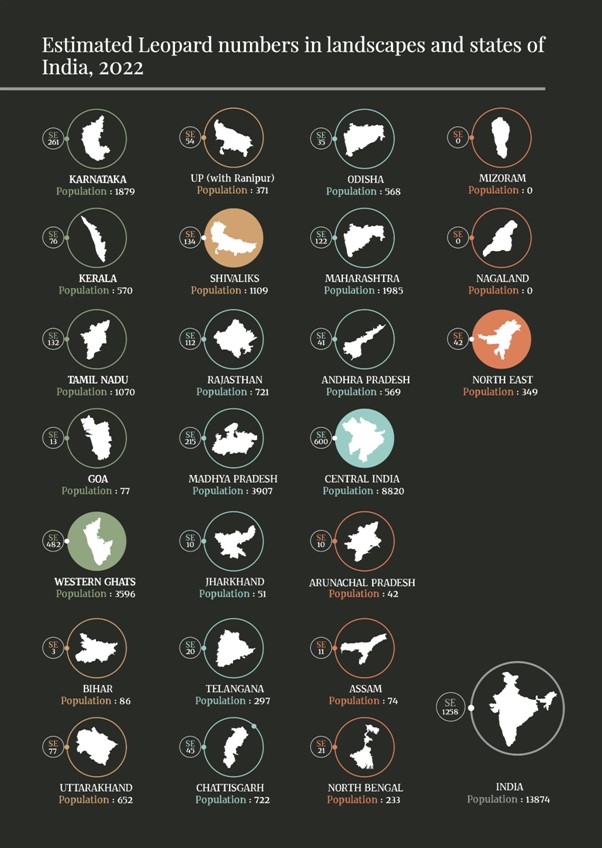
Status report of leopards in india

02.03.2024
Status report of leopards in india , Daily Current Affairs , RACE IAS : Best IAS Coaching in Lucknow
|
For Prelims: Main findings of the report on the status of leopards in India,Important points,States with maximum number of leopards in India,About Indian Leopard |
Why in the news?
The report on the status of leopards in India was released by the Union Minister for Environment, Forest and Climate Change, Shri Bhupendra Yadav in New Delhi on February 29, 2024.
Important points:
- The fifth cycle leopard population estimate was conducted by the National Tiger Conservation Authority and the Wildlife Institute of India, in collaboration with state forest departments, as part of a quadrennial monitoring exercise on tigers, co-predators, prey and their habitats.
- The fifth cycle of leopard population assessment in India (2022) focuses on forest habitats within 18 tiger states, including four major tiger conservation scenarios.
- Non-forest habitats above 2000 msl (~30% area) were not sampled for leopards in the arid and high Himalayas.
- This cycle surveyed 6,41,449 km on foot to estimate carnivore characteristics and prey abundance.
- Camera traps were strategically placed at 32,803 locations.
Main findings of the report on the status of leopards in India:
- The leopard population in India is estimated at 13,874 (range: 12,616 – 15,132), which was 12,852 (12,172-13,535) in 2018.
- This estimate represents 70% of the population in leopard habitat.
- The Himalayas and semi-arid parts of the country, which are not the habitat of tigers, have not been sampled.
- Central India has seen a stable or slightly increasing population of leopards, which is estimated at 8071 in 2018 and 8820 in 2022.
- According to this report, a decline has been observed in the Shivalik hills and the Ganga plains, from 1253 in 2018 to 1109 in 2022.
- If we compare both the samples of 2018 and 2022 in India, then a growth of 1.08% per year has been observed.
- While the largest growth rate of 1.5% has been observed in Central India and Eastern Ghats.
- According to the report, in the Shivalik Hills and the Gangetic plains, the degradation is occurring at the rate of 3.4% per year.
- The tiger reserves or sites with the highest leopard population are Nagarjunasagar, Srisailam (Andhra Pradesh), Panna (Madhya Pradesh), and Satpura (Madhya Pradesh) respectively.
States with maximum number of leopards in India:
- Madhya Pradesh 3907 (2018: 3421).
- Maharashtra 1985 (2018: 1,690).
- Karnataka 1,879 (2018: 1,783).
- Tamil Nadu 1,070) (2018: 868).
About Indian Leopard:
- Its scientific name is Panthera pardus fusca.
- conservation status :
- It has been classified as near threatened under the IUCN.
- Citations – in Appendix I.
- Placed in Schedule I of the Wild Life Protection Act, 1972.
Source: PIB